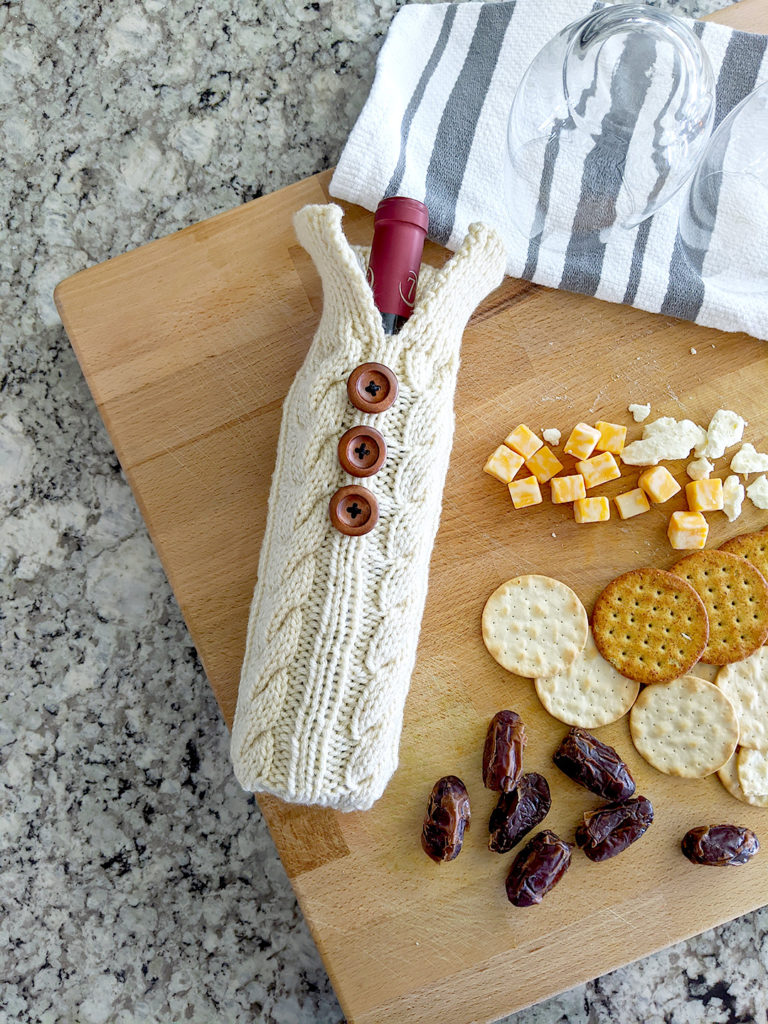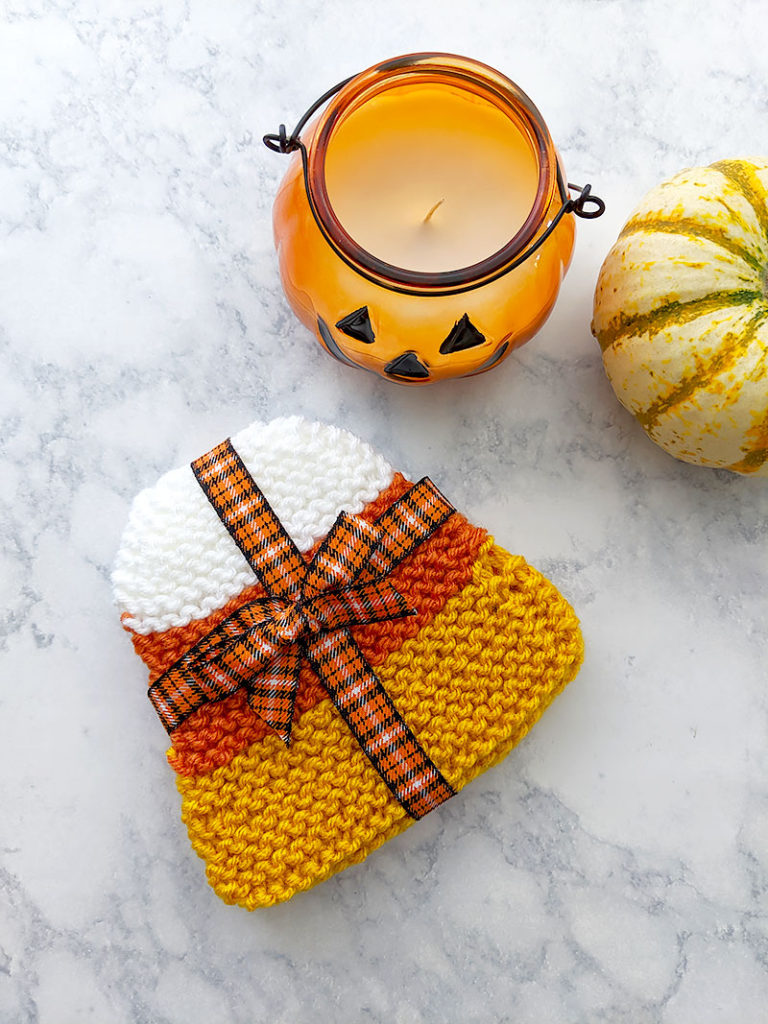Knitting can be very relaxing, but if you’re just starting out, the sight of a knitting pattern full of abbreviations and instructions can be a bit overwhelming. Learning how to read knitting patterns will open your knitting world, at least it did for me! Once I learned to read patterns, I went from knitting for the sake of knitting to making sweaters and socks. In this detailed guide, I break down how to understand knitting patterns, from start to finish.
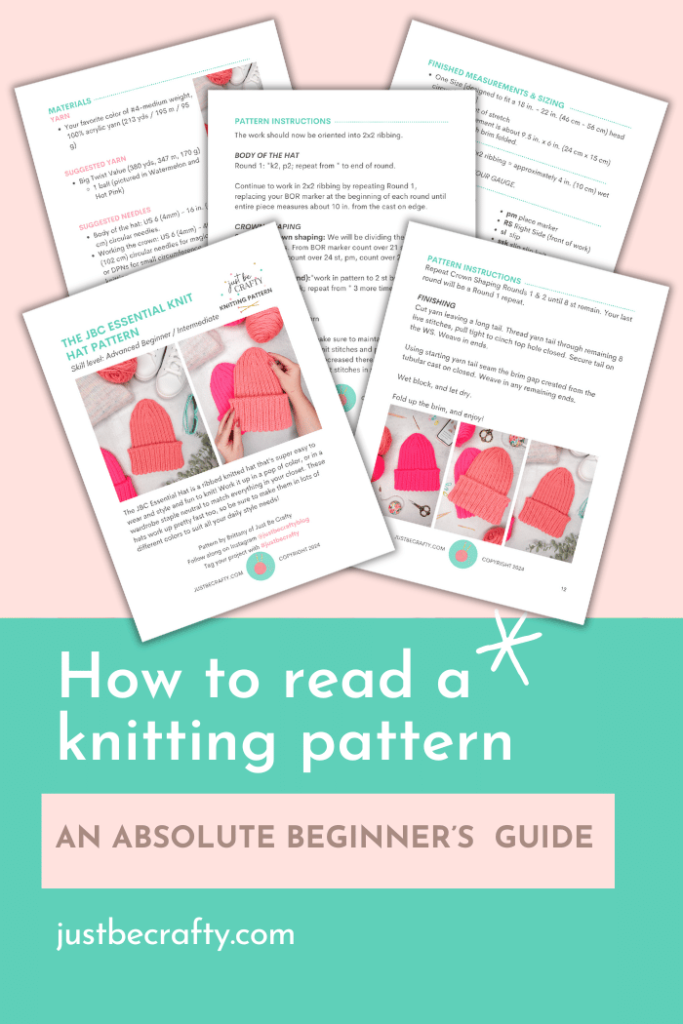
What is a Knitting Pattern?
A knitting pattern is essentially a recipe that tells you exactly how to create a specific knitted project. It tells you the necessary materials, techniques, and instructions. While each pattern may vary slightly depending on the designer, most follow a standard format that includes the following sections:
- Materials List: Specifies the type of yarn, needle size, and other tools required.
- Abbreviations: Shortened forms of knitting terms that are used throughout the instructions.
- Gauge: This tells you how many stitches and rows fit into a given measurement. This information is crucial, but we’ll talk more about this later!
- Sizing & Finished Measurements: Patterns should always list the sizes it is giving instructions for, such as Small, Medium, Large, or One Size. A pattern should also always list the finished measurements for each size.
- Step-by-Step Instructions: Detailed instructions that are given row by row or round by round.
Learning how to read knitting patterns is one of the first steps in learning to knit and guide you through a project step by step.
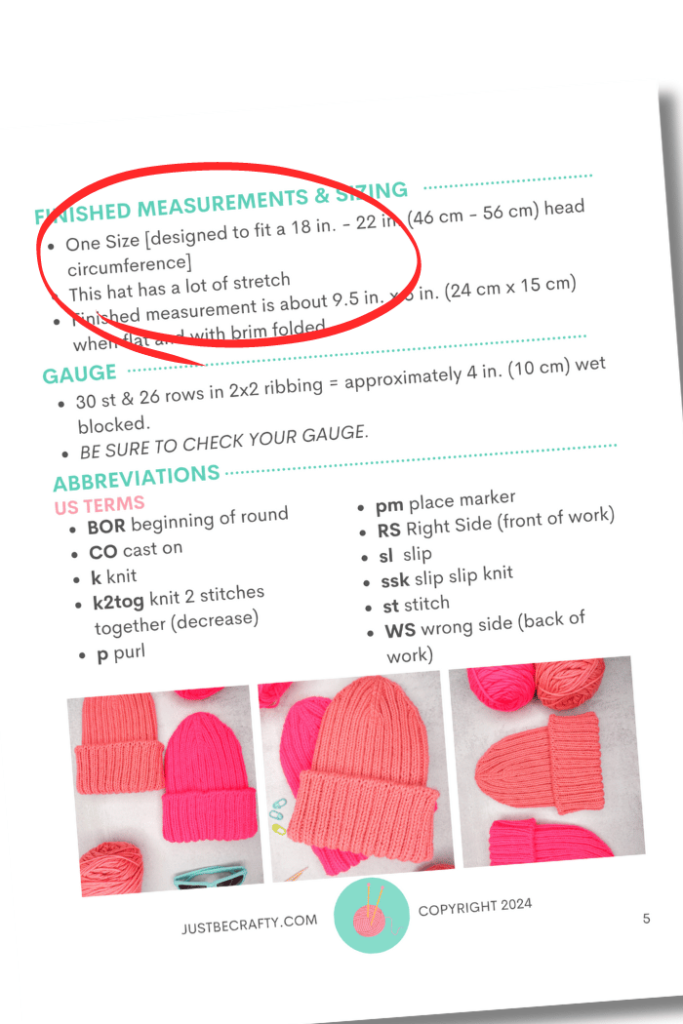
Common Abbreviations and Symbols in Knitting Patterns
Knitting patterns use a shorthand system of abbreviations to save space and make instructions easier to read. Here are some of the most commonly used abbreviations you’ll encounter in a knitting pattern:
- CO – Cast on (start your project)
- K – Knit
- P – Purl
- K2tog – Knit two stitches together (a decrease)
- YO – Yarn over (creating an additional stitch)
- BO – Bind off (finish your project)
- RS/WS – Right side/Wrong side (the visible side of your work versus the backside)
Standard US terms Sourced from: Craft Yarn Council
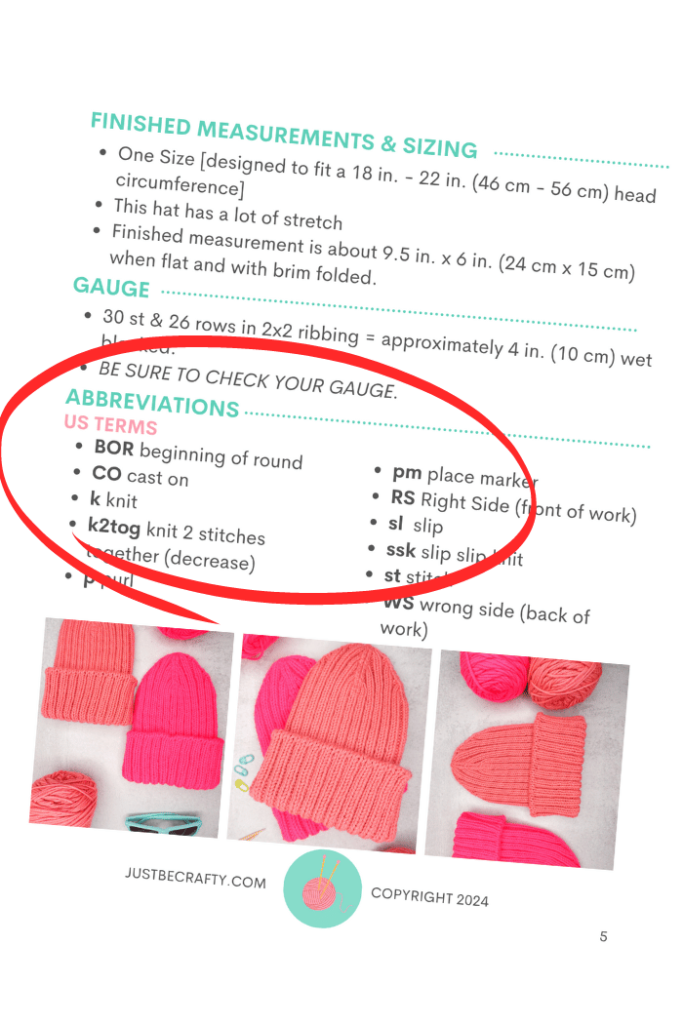
Many patterns also incorporate more complex techniques like cabling or decreasing and increasing, which have their own abbreviations:
- C4F – Cable 4 Front (slip two stitches to a cable needle and hold in front of work)
- SSK – Slip, slip, knit (a left-leaning decrease)
Special Symbols in Patterns
Some knitting patterns, especially lace and colorwork, use symbols such as brackets and parentheses. Here’s how to interpret them:
- [ ]: Denotes a set of instructions to repeat a certain number of times.
- ( ): Indicates stitch groups or sizing variations.
- *: Marks where to repeat a section of instructions.
For example, you might see: Row 3: K2, [YO, K2tog] 4 times, K2.
This means you’ll work “YO, K2tog” four times, and then knit two stitches to finish the row.
Or, you might see: Row 2: *K3, P2, repeat from * until the end of the row.
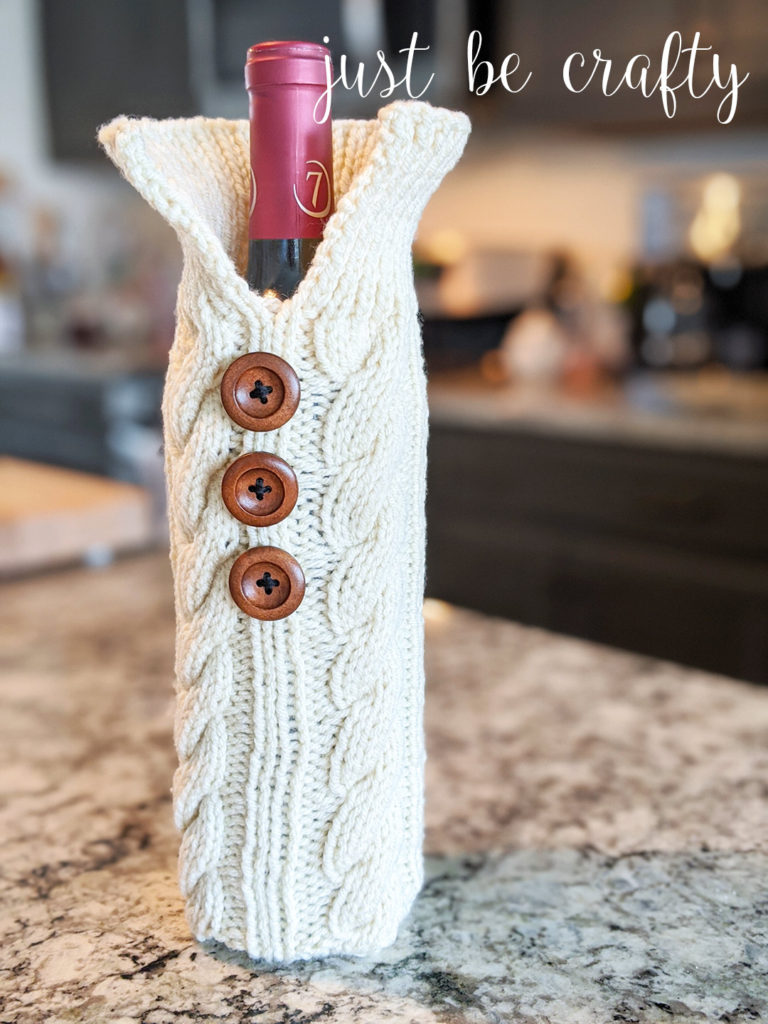
For a beginner friendly knitted cable project, check out my Wine Bottle Sweater Pattern here.
Understanding Yarn and Gauge in Patterns
Yarn Weights and Types
Every knitting pattern includes a Materials List that specifies the type of yarn to use, as well as the quantity. Yarn is categorized by weight, which refers to its thickness. The most common categories are:
- Lace (#1-fine): Fine and delicate, used for intricate designs.
- Fingering (#2-fine): Thin, used for lightweight projects like socks.
- Worsted (#4-medium): Medium weight, great for sweaters and scarves.
- Bulky (#5-bulky): A thicker yarn for chunkier projects like blankets.
It’s important to follow the yarn weight recommended in the pattern to ensure your project turns out correctly. Substituting yarns can affect the size and feel of your finished item. In addition to using the recommended yarn weight, you must always check your gauge (learn more about gauge below!).
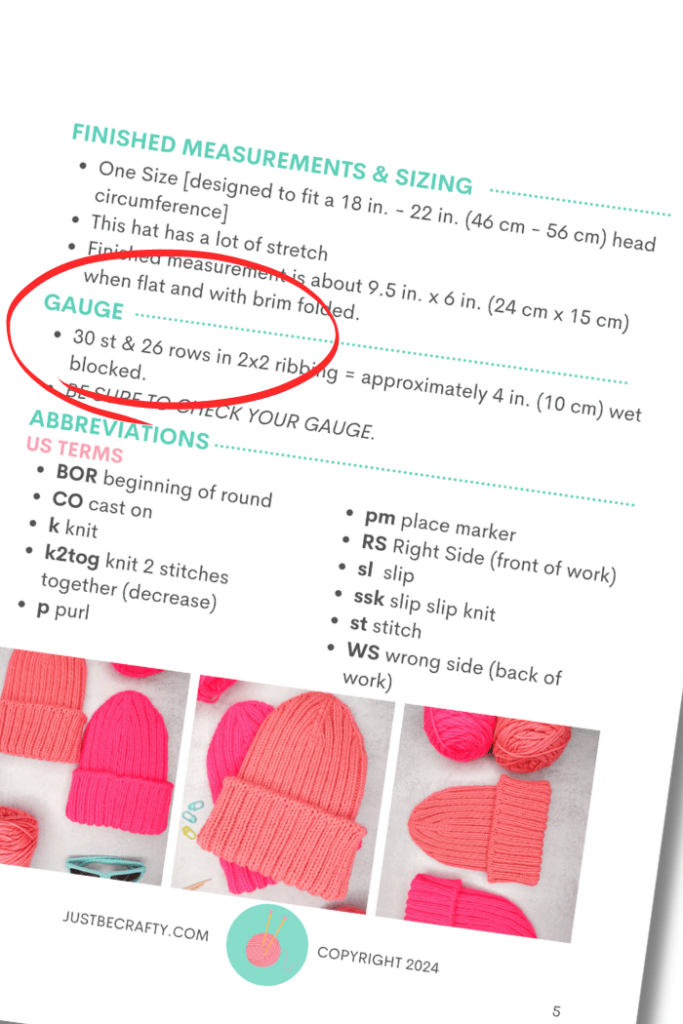
Gauge: Why It Matters
The gauge section of a pattern tells you how many stitches and rows fit inside a certain measurement (usually 4″ (10 cm)) when using the recommended yarn and needle size. Matching the gauge is essential, particularly for garments or items that require a specific fit. If gauge is not met, the finished item will not fit.
For example, the pattern might specify:
Gauge: 20 stitches and 28 rows = 4 inches in stockinette stitch.
To check your gauge, knit a small square (usually around 6×6 inches), then measure how many stitches and rows fit within a 4×4 inch square. If your gauge doesn’t match that of the pattern, you will need to change your needle size in order to adjust your tension.
If gauge is not met, your finished project will not come out to the size listed in the pattern.
How to Read Knitting Instructions Step-by-Step
Let’s break down a typical knitting pattern step-by-step, so you can easily follow along:
Cast On, Knit, and Purl
Most knitting patterns start with instructions for casting on the stitches. This forms the foundation of your project. If a cast on method is not specified, then you’ll typically want to do the Long Tail Cast On, or you can use your own preferred method.
- CO 32 stitches: This means you’ll cast on 32 stitches onto your needle.
- Once you’ve cast on, the pattern will tell you whether to knit or purl.
Understanding Rows, Rounds, and Repeats
Patterns are usually written in either rows or rounds (if you’re knitting in the round, you’ll use either double pointed needles or circular needles).
With rows, for example you’ll be working back and forth switching between knitting on the front of your work and on the back of your work:
Row 1 (RS): K all sts: Knit all stitches across the right side (the visible side of your work).
Row 2 (WS): P all sts: Purl all stitches across the wrong side (the backside of your work).
Some patterns will include repeats or sections that must be worked multiple times. For instance:
Rows 3-6: Repeat Rows 1-2.
This means you’ll go back and repeat the instructions from Rows 1 and 2 twice more.

How to Interpret Knitting Charts
Many knitting patterns include charts to visually represent stitch patterns, especially for lace, cables, or colorwork. Knitting charts use symbols to indicate different stitches, which are read from right to left on right-side rows and left to right on wrong-side rows.
Common Symbols in Knitting Charts
- Blank square: Knit stitch.
- Dash: Purl stitch.
- Circle: Yarn over.
- Slanting lines: Indicate decreases, such as K2tog or SSK.
Charts can seem daunting at first, but once you understand the symbols, they can make complex stitch patterns much easier to follow.
Shaping and Advanced Techniques in Patterns
As you advance, you’ll come across patterns that require shaping. Shaping refers to increasing or decreasing stitches to create curves, like in sleeves or necklines.
Decreasing
To shape a project, you’ll often need to decrease stitches. Common decrease techniques include:
- K2tog (Knit two together): This creates a right-leaning decrease.
- SSK (Slip, slip, knit): A left-leaning decrease.
For example, you might see: Row 5: K2, SSK, K to last 4 stitches, K2tog, K2.
This means you’ll decrease two stitches on either side of the row to create a gentle shaping.
Increasing
Similarly, increasing stitches adds width. The yarn over (YO) is a common technique to add stitches, especially in lace knitting.
Common Mistakes When Reading Patterns & How to Avoid Them
Even seasoned knitters can misinterpret patterns. Here are a few common mistakes and how to fix them:
Misreading Abbreviations
It’s easy to confuse abbreviations like K2tog and SSK, especially when working quickly. Keep a handy chart of abbreviations nearby or make notes in the margin of your pattern to avoid confusion.
Not Checking Gauge
If your project doesn’t match the pattern’s gauge, your item will end up too big or too small. Always knit a gauge swatch before starting a new project, especially for wearables like sweaters.
Forgetting to Count Stitches
Many knitters lose track of their stitches mid-row. Try using stitch markers to section off repeated parts of a pattern or count out loud to keep track of where you are.
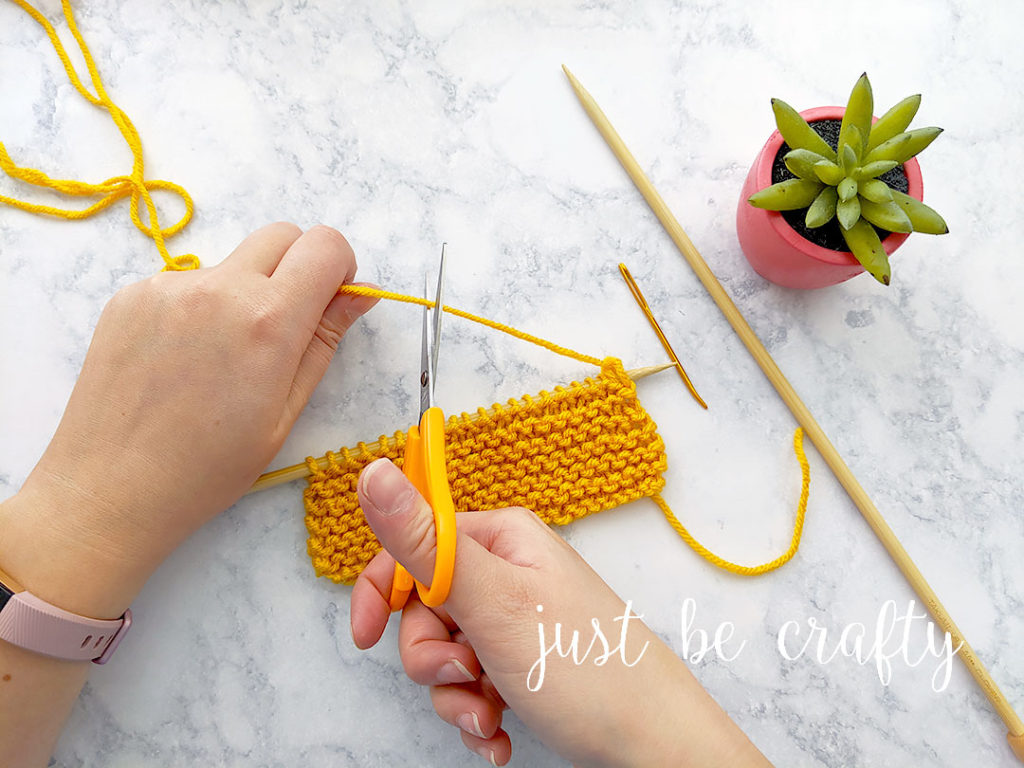
Tips for Knitting Pattern Success
- Start Simple: If you’re new to knitting patterns, begin with a basic scarf or dishcloth. These patterns often use straightforward stitches and easy-to-follow instructions.
- Use Stitch Markers: Mark important sections of your pattern to stay on track, especially when working with complex designs.
- Take Notes: Write down any adjustments or tricky parts of the pattern as you go. This will make future projects easier.
- Watch Video Tutorials: A lot of my patterns include helpful video tutorials that can walk you through new stitches or techniques.
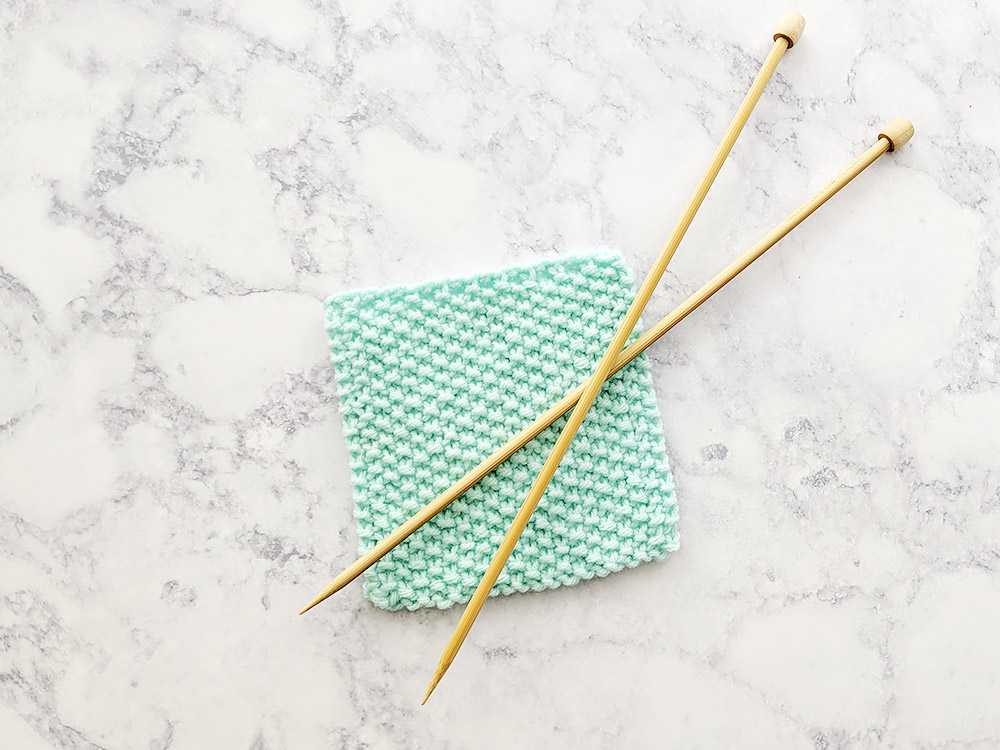
Frequently Asked Questions (FAQs)
Can I Substitute Yarn in a Knitting Pattern?
Yes, but keep in mind that different yarn weights and fibers can change the size and texture of your finished item. Always check the gauge when substituting yarn (and even when you’re not!).
What Do I Do if I Don’t Understand a Part of the Pattern?
Look for online knitting communities or video tutorials that explain specific techniques. You can also contact the pattern designer for clarification. If its one of my patterns, I’m always happy to help! Just send me an email with your questions!
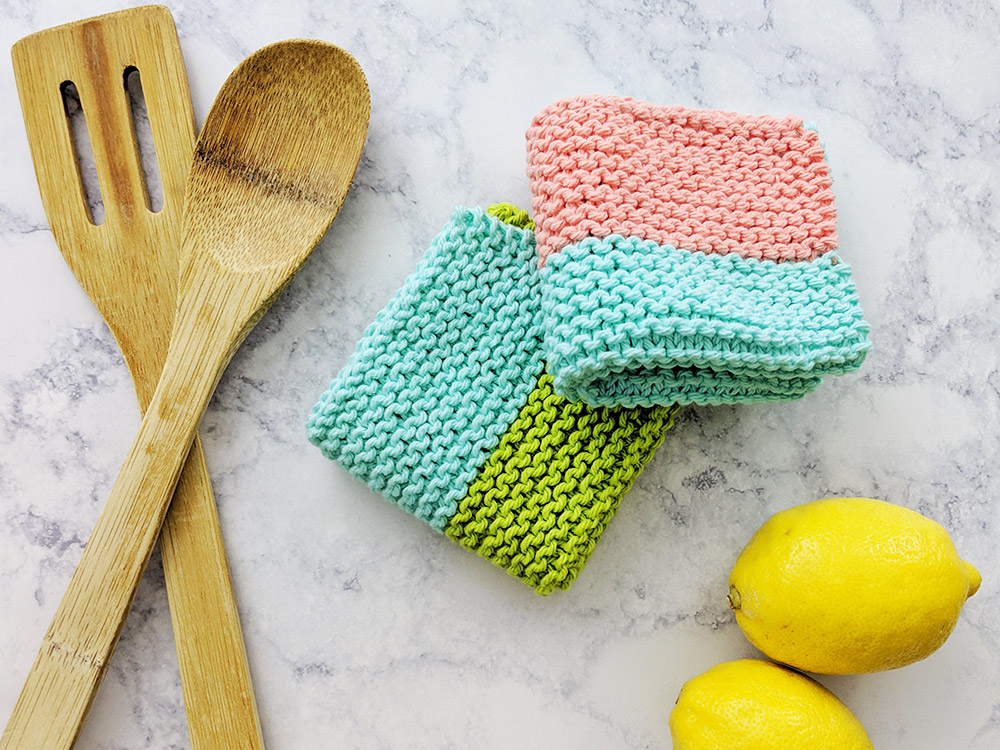
Before you go!
Learning how to read knitting patterns takes practice, but it’s an important skill that will allow you to create beautiful projects of all kinds. By learning the abbreviations, understanding gauge, and interpreting instructions, you’ll be well-equipped to tackle pattern you want to try. Happy knitting!

